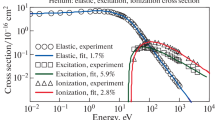Abstract
In order to find the total collision cross-section a direct method of the effective potential (EPM) in the framework of classical mechanics was proposed. EPM allows to over come both the direct scattering problem (calculation of the total collision cross-section) and the inverse scattering problem (reconstruction of the scattering potential) quickly and effectively. A general analytical expression was proposed for the generalized Lennard-Jones potentials: (6–3), (9–3), (12–3), (6–4), (8–4), (12–4), (8–6), (12–6), (18–6). The values for the scattering potential of the total cross section for pairs such as electron–N\(_{2}\), N–N, and O–O\(_{2}\) were obtained in a good approximation.
Similar content being viewed by others
Abbreviations
- \((m-n)\) :
-
The generalized Lennard-Jones potential with the degrees m and \(n (m>n)\): \(U(r)=C_{m,n}\epsilon \left( {\left( {\frac{d}{r}} \right) ^{n}-\left( {\frac{d}{r}} \right) ^{m}} \right) =\frac{A}{r^{m}}-\frac{B}{r^{n}}\), J
- \(C_{m,n}\) :
-
\(\frac{n}{n-m}\left( {\frac{n}{m}} \right) ^{\frac{m}{n-m}}\)
- U(r):
-
The scattering potential, J
- \(\epsilon \) :
-
The function minimum, J
- d :
-
The collision diameter, m
- \(\alpha \) :
-
The polarizability, m\(^{3}\)
- \(\varepsilon \) :
-
The dielectric environment permittivity
- \(\varepsilon _0\) :
-
The electric constant, 8.8541 \(\times \) 10\(^{-12}\) F/m
- e :
-
The elementary electronic charge, 1.6021766208 \(\times \) 10\(^{-19}\) Kl
- \(\mu \) :
-
The reduced mass, \(\mu =\frac{m_1 m_2 }{m_1 +m_2 }\) kg
- \(v_\infty \) :
-
The velocity at infinity, m/s
- \(p_\infty \) :
-
The impulse at infinity, kg m/s
- \(\rho \) :
-
The impact parameter, m
- \(r^{*}\) :
-
The first real root of equation \(U(r)=0\), \(r\ge 0\)
References
C.J. Joachain, P.G. Burke, Theory of Electron–Atom Collisions: Part One: Potential Scattering (Springer, Berlin, 1995)
P.G. Burke, R-Matrix Theory of Atomic Collisions: Application to Atomic, Molecular and Optical Processes (Springer, Berlin, 2011). https://doi.org/10.1007/978-3-642-15931-2
I.G. Kaplan, Intermolecular Interactions: Physical Picture, Computational Methods and Model Potentials (Wiley, New York, 2006). https://doi.org/10.1002/047086334X
E.E. Nikitin, S.Y. Umanskii, Theory of Slow Atomic Collisions (Springer, Berlin, 2012)
V.B. Leonas, Sov. Phys. Usp. (1964). https://doi.org/10.1070/PU1964v007n01ABEH003648
P.L. Huyskens, W.A.P. Luck, T. Zeegers-Huyskens, Intermolecular Forces: An Introduction to Modern Methods and Results (Springer, Berlin, 2011). https://doi.org/10.1002/ange.19921041161
L.D. Landau, E.M. Lifshitz, Course of Theoretical Physics: Mechanics, vol. 1 (Elsevier, Amsterdam, 1982)
I.V. Repin, I.A. Sokolova, Algorithms for calculating deflection angle and phase shift. Matem. Mod. 5(4), 76–88 (1993)
N.N. Kalitkin, N.A. Slavinskaya, I.A. Sokolova, Matem. Mod. 13, 5 (2001)
V.N. Popov, High Temp. (2013). https://doi.org/10.1134/S0018151X13010124
G. Colonna, A. Laricchiuta, Comput. Phys. Commun. (2008). https://doi.org/10.1016/j.cpc.2008.01.039
S.U. Kim, C.W. Monroe, J. Comput. Phys. (2014). https://doi.org/10.1016/j.jcp.2014.05.018
A. Laricchiuta, G. Colonna, D. Bruno, R. Celiberto, C. Gorse, F. Pirani, M. Capitelli, Chem. Phys. Lett. (2007). https://doi.org/10.1016/j.cplett.2007.07.097
D. Frenkel, B. Smit, Understanding Molecular Simulation From Algorithms to Applications, 2nd edn. (Academic Press, Cambridge, 2001)
M. Capitelli, D. Cappelletti, G. Colonna, C. Gorse, A. Laricchiuta, G. Liuti, S. Longo, F. Pirani, Chem. Phys. (2007). https://doi.org/10.1016/j.chemphys.2007.07.036
F.G. Hoyt, Phys. Rev. 55, 664 (1939)
O.B. Firsov, JETP 24, 279 (1953)
Sydney Geltman, Topics in Atomic Collision Theory (Academic Press, Cambridge, 2013)
L.D. Landau, E.M. Lifshitz, Quantum Mechanics: Non-Relativistic Theory, 3rd edn. (Elsevier, Amsterdam, 2013)
B.M. Smirnov, Phys. Usp. (2001). https://doi.org/10.1070/PU2001v044n12ABEH000959
D.L. Tsyganov, High Temp. (2014). https://doi.org/10.7868/S0040364413060203
D.L. Tsyganov, High Temp. (2017). https://doi.org/10.7868/S0040364417010227
Y. Itikawa, J. Phys. Chem. Ref. Data (2006). https://doi.org/10.1063/1.1937426
B.P. Nikolsky (ed.), Chemist’s Handbook, vol. 1 (Nauka, Leningrad, 1982). (in Russian)
J.R. Stallcop, H. Partridge, E. Levin, Phys. Rev. (2001). https://doi.org/10.1103/PhysRevA.64.042722
J.E. Morgan, H.I. Schiff, Can. J. Chem. (1964). https://doi.org/10.1139/v64-337
F. Pirani, D. Cappelletti, V. Aquilanti, in Molecular Physics and Hypersonic Flows, ed. by M. Capitelli (Kluwer Academic, Dordrecht, 1996), p. 351
B. Brunetti, G. Liuti, E. Luzzatti, F. Pirani, F. Vecchiocattivi, J. Chem. Phys. (1981). https://doi.org/10.1063/1.441130
Author information
Authors and Affiliations
Corresponding author
Rights and permissions
About this article
Cite this article
Tsyganov, D.L. Calculations of Total Classical Cross Sections for a Central Field. Few-Body Syst 59, 74 (2018). https://doi.org/10.1007/s00601-018-1394-7
Received:
Accepted:
Published:
DOI: https://doi.org/10.1007/s00601-018-1394-7



